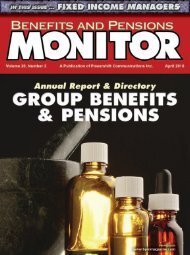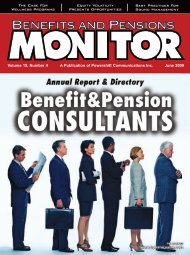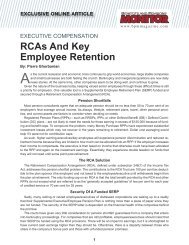BPM October 2010.indd - Benefits and Pensions Monitor
BPM October 2010.indd - Benefits and Pensions Monitor
BPM October 2010.indd - Benefits and Pensions Monitor
You also want an ePaper? Increase the reach of your titles
YUMPU automatically turns print PDFs into web optimized ePapers that Google loves.
In the 30 to 40 years since most multi-employer<br />
<strong>and</strong> public sector pension plans have been in<br />
existence, the most signifi cant change in funding<br />
requirements occurred in the late 1980s<br />
when the majority of jurisdictions introduced solvency<br />
funding requirements. More recently, while<br />
there may not be complete agreement on the reasons<br />
for additional change or the type of change required,<br />
plan sponsors, members, regulators, <strong>and</strong> the Canadian<br />
Institute of Actuaries (CIA) have all expressed<br />
opinions that changes to the funding rules are now<br />
required. This article places this important development<br />
in context <strong>and</strong> addresses the implications for<br />
sponsors of multi-employer <strong>and</strong> public sector pension<br />
plans.<br />
Rising Funding Costs<br />
The economic conditions in the late 1980s facilitated<br />
the introduction of solvency funding as pension<br />
plans were generally well funded <strong>and</strong> interest<br />
rates were high. Generally, solvency funding was a<br />
non-issue for most pension plans when the concept<br />
was fi rst introduced.<br />
Over the last two decades, both going-concern<br />
<strong>and</strong> solvency funding requirements have increased.<br />
The Dawn 26 pt. Of Futura A New Cond. Funding BoldEra?<br />
During that period, solvency funding has replaced<br />
going-concern funding as the primary determinant<br />
of funding for most pension plans due to decreasing<br />
interest rates <strong>and</strong> the corresponding increasing commuted<br />
values. For the majority of active members<br />
in a pension plan, the solvency liability is equal to<br />
a member’s commuted value. As depicted in Chart<br />
1, pension plan commuted-value payments have<br />
been increasing continuously <strong>and</strong>, for the most part,<br />
relentlessly since 1990 in conjunction with declining<br />
interest rates.<br />
Funding costs for pensioners have also been on<br />
the rise. From the interest rate peak in 1990 to today,<br />
the cost of purchasing a $500 monthly life annuity<br />
for a 65-year-old male participant has increased more<br />
than 60 per cent from $46,000 to $74,000. Depending<br />
on the plan design <strong>and</strong> the economic strength of<br />
the underlying industries, some plans have been able<br />
to manage within this rising cost environment much<br />
better than others.<br />
<strong>Benefits</strong> <strong>and</strong> <strong>Pensions</strong> <strong>Monitor</strong> – <strong>October</strong> 2010<br />
The pension industry has generally been reluctant<br />
to accept that it now costs more to provide the<br />
same monthly pension benefi t that could previously<br />
be provided for far less money. This new reality also<br />
made for a very diffi cult transition from the 1970s<br />
<strong>and</strong> 1980s, a period over which reducing costs,<br />
increasing contributions, <strong>and</strong> reasonably consistent<br />
investment results allowed boards to increase<br />
benefi ts on numerous occasions. Regardless of the<br />
extent to which additional funding has been secured<br />
by each pension plan over the last 10 to 20 years, the<br />
going-concern margins for adverse experience that<br />
previously existed in the 1990s generally eroded or<br />
were superseded over the last decade. Hence, many<br />
plans had little or no margin when the broad-based<br />
equity declines in late 2008 dealt a signifi cant blow<br />
to the fi nancial position of any pension plan having<br />
equity exposure.<br />
Plan Sponsors’ Concerns<br />
Single employer pension plan sponsors are seeking<br />
a solution to the asymmetrical rules that expose<br />
them to signifi cant liabilities in the face of poor<br />
experience, while constraining the gains resulting<br />
from any good experience. Combined with rising<br />
<strong>and</strong> volatile funding requirements, the corporate<br />
response in this environment has been predictable –<br />
minimize funding, freeze the accrued pension <strong>and</strong><br />
convert to a Defi ned Contribution approach, or terminate<br />
the Defi ned Benefi t coverage completely.<br />
Multi-employer plan stakeholders have been<br />
fi ghting their own battle against solvency funding<br />
requirements. The relatively inoffensive introduction<br />
of these rules in the late 1980s turned invasive<br />
when lower interest rates meant that going-concern<br />
funding requirements were superseded by solvency<br />
funding st<strong>and</strong>ards. M<strong>and</strong>ated benefi t reductions<br />
revealed the fallacy of the benefi t security argument<br />
for solvency funding requirements as applied<br />
to multi-employer plans. Affected plan participants<br />
received a crash course on the nature of their ‘guaranteed’<br />
pension plans <strong>and</strong> much of the bad news has<br />
yet to be shared as required corrective actions arising<br />
from 2008 year-end actuarial valuations are still<br />
being developed.<br />
PENSIONS<br />
By: Phil M.<br />
Rivard<br />
25









